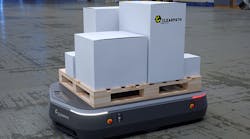Automated Material Handling Moving Off the Track and Onto the Plant Floor
Sometime this year, a fleet of new-generation AGVs will begin zipping through the lanes of the John Deere’s Horicon, Wis., plant assembly line, hauling parts and materials across the plant in an efficient, automated buzz.
On the face of it, there is nothing too exciting about this news. Automated Guided Vehicles are nothing new to the market; they have been scurrying around plants in one form or another for decades already.
But none of them have ever been quite like these.
John Deere’s fleet will mark the latest deployment of OTTO 1500—a fully self-driving, autonomous robotic vehicle built by a new player in the space, Ontario-based Clearpath Robotics.
The machines are capable of transporting up to 3,000 lb of goods through congested plant and warehouse environments without the need for drivers, supervision, or guidance infrastructure.
That last detail is what makes this technology exciting.
Traditional AGVs require a lot of work and a lot of free space to run safely and efficiently. In the past, this has meant tying them to magnetic strips or grids of barcodes crisscrossing human-free transport lanes.
But not anymore.
According to Clearpath co-founder and CEO, Matt Rendall, OTTO taps into the same sensor-driven, high-computing backbone of Google’s self-driving car to safely and efficiently transport supplies along the same plant and warehouse paths populated by workers and equipment.
“The key difference between OTTO and previous generations of this technology is that fundamentally OTTO is off the track,” explains Rendall.
He likens the distinction to the difference between subway systems and taxis in a busy city.
“There is a time and a place for a subway system,” he says. “But when speed and efficiency are needed, there is also a time and a place for taxi cabs.”
However, creating a robot smart enough to safely traverse a busy plant is a far cry from trusting an experienced driver to get you to the office on time. To make that jump, Clearpath had to tap into the full arsenal of today’s technological tools.
More on Self-Driving Robots on NED.
NED is a companion site to MH&L within Penton's Manufacturing & Supply Chain Group.



